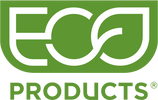Materials
Renewable Resources
PLA Plant-Based Plastic
Polylactic Acid (PLA) is derived from plants like corn, sugarcane, or cassava. These plant-based starches are processed into a biopolymer that looks, acts, and performs like a traditional petroleum-based plastic.
With the circular benefits of being made from renewable, plant-based materials and being compostable in commercial composting facilities – this versatile raw material is a fan favorite for earth-loving fans.
You will find PLA in many of our GreenStripe® products, from PLA-lined molded fiber, to clear cold cups, clear clamshells and deli containers, and even CPLA (crystalized PLA) for heat tolerant cutlery and hot cup lids.
Plant Fiber
Sugarcane is grown primarily for cane juice extraction. Once the juice is extracted, the remaining sugarcane fiber, known as bagasse, is commonly incinerated or discarded. By using bagasse as a material input for our molded fiber products, we are helping to promote the reclamation of this versatile, renewable resource.
Bamboo is the fastest growing plant in the world and is considered a rapidly renewable resource with many climate benefits. Many bamboo species sequester more carbon than their tree counterparts and reintroduce more oxygen to the atmosphere. According to Project Drawdown, bamboo rapidly sequesters carbon in biomass and soil and can thrive on degraded lands.
Since bamboo grows from its own root system, it does not require an ecosystem-disturbing replanting process and is naturally renewable. This helps the soil remain undisturbed, which aids in water retention and preventing soil erosion. It can also provide economic benefits to its farmers, as it can be grown on land that may not be suitable for other agricultural purposes, due to its versatility. Bamboo can be composted at the end of its life.
We use sugarcane and bamboo in our broad array of GreenStripe® molded fiber products including plates, bowls, and trays.
PHA Plant-Based Plastic
Polyhydroxyalkanoate (PHA)
is a naturally occurring biopolymer produced by bacterial fermentation of sugar or lipids. Since these polyhydroxyalkanoates are produced by micro-organisms, it is more accurate to refer to their production as biosynthesis.
Since PHA is made from plants, it is an attractive energy and food source to the bacteria that participate in decomposition. This allows PHA versatility in its breakdown location, whether that be a commercial compost facility or backyard composting.
PHA is a great material for making straws which is why we use it in the GreenStripe® line today.
Wood
We use birch wood for wooden cutlery and stir sticks. Wood is a plant-based renewable resource that is compostable at end of life.
Paper
Paper is a plant-based, renewable resource produced from trees. It is compostable at end of life, and occasionally recyclable depending on food residue and acceptance in local programs.
We use virgin paperboard in GreenStripe® hot cups and paper food containers.
PBAT
Polybutylene Adipate Terephthalate (PBAT) is a versatile material that is derived from petroleum, but can be combined with bio-based materials to create blended copolymers that are compostable at end of life.
We use PBAT in shopper bags, can liners, and select cutlery wrappers.
Post-Consumer Recycled Content
rPET Plastic
Polyethylene Terephthalate (PET) is one of the most common plastics in the world. You have probably seen this plastic in your soda and water bottles that are marked with the resin code #1.
PET is petroleum-based and is one of the most commonly recycled plastics – particularly when it is in bottle form. Post-consumer recycled PET (rPET) provides a new life to plastics that would have otherwise gone to a landfill, while also creating opportunities for other products to be made from a post-consumer resource.
We use the highest amount of rPET that we possibly can in the different products we make from this material – anywhere from 30% to 100%.
Fewer virgin traditional PET + more post-consumer recycled PET = a lower product carbon footprint potential and supports a more circular approach to resource use.
We use post-consumer recycled PET (rPET) in our BlueStripe cold cups and lids, as well as in many of the lids that go on molded fiber bases. NONE of these items are compostable.
rPS Plastic
Polystyrene (PS) is a common petroleum-based plastic that can be identified using resin code #6.
Just as with rPET, we use the highest amount of post-consumer rPS that we possibly can in the different products we make from this material – anywhere from 25% – 100%.
We use rPS in our BlueStripe hot cup lids and cutlery. NONE of these items are compostable.
PCF Paper
Post-Consumer Recycled Fiber (PCF) is paper that has been used, recycled, and repurposed for use in new items. We use PCF in our food trays (70%) and EcoGrips™ (85%).
Raw materials listed above do not include lining, coating, chemistry, or wax that are used in the formulation of our products.
